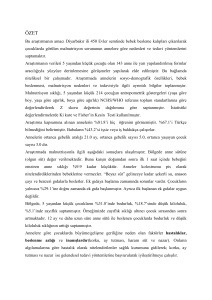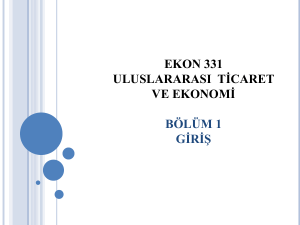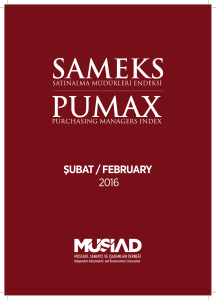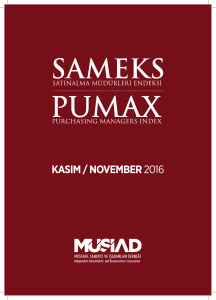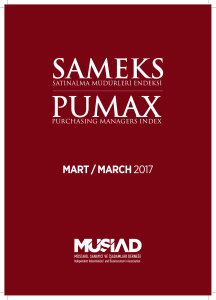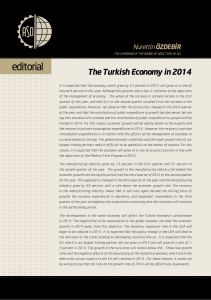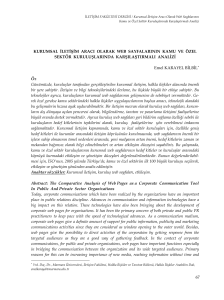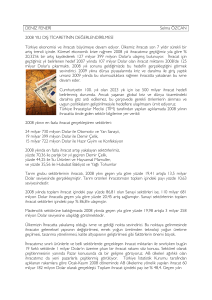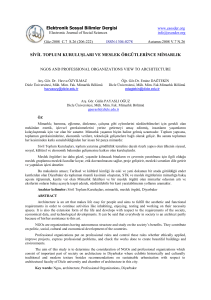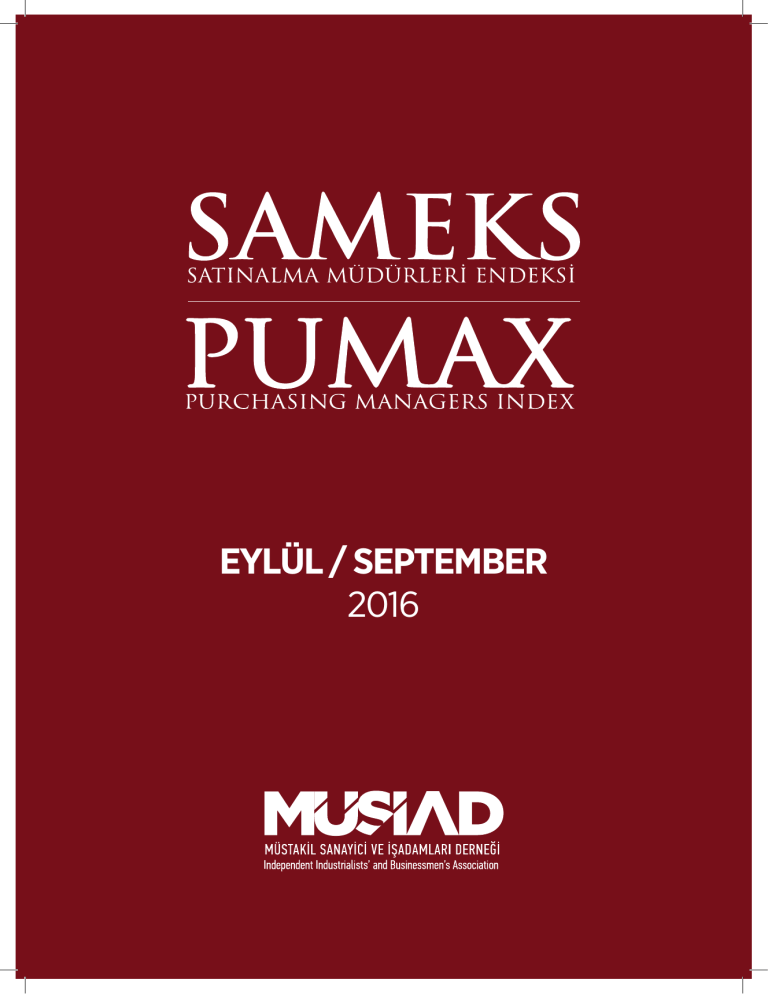
EYLÜL / SEPTEMBER
2016
SAMEKS
PUMAX
Sanayi sektöründe yeni siparişlerin sert düşüşü endeksin artış hızını yavaşlatırken, hizmet sektöründe Temmuz ayından beri süregelen yavaşlama Eylül ayında da sürmüştür.
Böylece SAMEKS Bileşik Endeksi 48,6 puana
gerilemiştir.
Böylece SAMEKS Bileşik Endeksi, 48,6 puanlık değeriyle 50 referans puanını altında yer
almış ve Eylül ayında önceki aya göre ekonomik aktivitenin bir miktar yavaşladığına işaret
etmiştir.
A sharp drop in new orders in the industrial sector slows the increase rate of the index while the services sector saw continued
slowdown since July. Therefore, the PUMAX
Composite Index declined to 48.6 points.
mained below the 50 reference points with a
46.6-point value pointing to somewhat slowing economic activity in September compared
with the previous month.
1. Sanayi Sektörü SAMEKS Endeksi
SAMEKS Bileşik Endeksi1 2016 yılı Eylül ayında,
bir önceki aya göre 1,7 puan azalarak 48,6 puana gerilemiştir. Endekste gözlenen bu azalışta,
hizmet sektörünün önceki aya göre 2,1 puan
azalış kaydederek 50 referans puanının altında
seyretmesi etkili olmuştur. Sanayi sektörü ise
geçtiğimiz aya göre 0,5 puan azalmasına karşın 51,5 puanla sektörde ekonomik aktivitenin
canlılığını sürdürdüğüne işaret etmiştir.
SAMEKS Sanayi Endeksi, 2016 yılı Eylül ayında, bir önceki aya göre 0,5 puan azalarak 51,5
seviyesine gerilemiştir. Yeni Sipariş (7,0 puan)
ve İstihdam (2,6 puan) alt endeksinde gözlenen azalışlar, sanayi sektöründeki hız kaybının en önemli belirleyicileri olurken, Üretim
(4,1 puan), Satın Alım (1,6 puan) ve Nihai Mal
Stoku (10,6 puan) alt endekslerindeki artışlar,
endeksteki azalışı sınırlandırmıştır.
The PUMAX Composite Index fell to 48.6 in
September 2016 with a 1.7-point decrease compared with the previous month. The decline
of the services industry by 2.1 points over the
previous month to below 50 reference points
influenced this drop in the index. The industry
sector, on the other hand, indicated a buoyancy
in the sector’s economic activity at 49.6 despite
a 0.5-point decrease over the previous month.
Therefore, the PUMAX Composite Index re-
The PUMAX Industry Sector Index fell to 51.5
in September 2016 with a 0.5-point drop compared to the previous month. Declines in the
sub-indices of New Orders (7.0 points) and
Employment (2.6 points) became the most
important determinants of such deceleration. The increases in the Manufacturing (4.1
points), Purchasing (1.6 points) and the Final Goods Stock (10.6 points) limited the decrease in the index.
1
4
Arındırılmamış verilere göre hesaplanmıştır.
1
1. PUMAX Industry Sector Index
Calculated according to unadjusted data.
5
Yeni siparişlerdeki sert düşüşe rağmen girdi
alımları ve üretimin artış kaydetmesi, sanayi sektörüne ait nihai mal stokunun artışına
neden olmuştur. Bu durumda, önümüzdeki dönemde stoktan satışların artışıyla girdi
alımları ve üretimin yavaşlaması beklenebilir.
İstihdamın 50 referans puanının altına gerilemesi yeni siparişlerdeki 7,0 puanlık sert düşüşle açıklanırken, üretimdeki artışın sürmesi
ise üreticinin sektörün canlılığına olan güveninin sürdüğüne işaret etmektedir.
Eylül ayındaki 0,5 puanlık hız kaybına karşın,
SAMEKS Sanayi Endeksi 50 referans puanının
üzerindeki seyrini sürdürmüş ve sanayi sektöründe çarkların dönmeye devam ettiğini göstermiştir.
b. Yeni Sipariş
Sanayi sektörüne ait Yeni Sipariş alt endeksi, Eylül ayında bir önceki aya göre 7,0 puan
azalarak 47,8 seviyesine gerilemiştir. Yeni Siparişlerde gözlenen bu sert düşüş, sektördeki
yavaşlamanın belirleyicisi olmuştur.
c. Satın Alım
An increase in input purchases and manufacturing despite a sharp decline in new orders has
led to an increase in the industrial sector’s final
goods stock. In this case, we can expect input
purchases and manufacturing to slow down in
the coming period due to an increase in stock
sales. The decline of employment below 50 reference points is explained with a 7-point sharp
decline in new orders while the continued increase in production points to manufacturers’
continued faith in the industry’s vitality.
The PUMAX Industrial Sector Index continued
its course over 50 reference points despite a
0.5-point deceleration in September indicating that the industrial sector kept spinning the
wheels.
Sanayi sektörüne ait Satın Alım alt endeksi,
Eylül ayında bir önceki aya göre 1,6 puan artarak 56,7 seviyesine yükselmiştir. Böylece girdi
alımındaki bu artış, yeni siparişlerdeki azalışla
birlikte stoklarda hızlı bir yükselişe neden olmuştur.
a. Üretim
The New Orders sub-index of the industrial
sector fell to 47.8 in September 2016 with a
7.0-point decrease compared with the previous month. This sharp decline in New Orders
became a determining factor for the industry’s slowdown.
c. Purchasing
The Purchasing sub-index of the industrial sector rose to 56.7 in September with a
1.6-point increase compared with the previous
month. Therefore, higher input purchases led
to a quick increase in stocks together with the
decline in new orders.
a. Production
Sanayi sektörüne ait Üretim alt endeksi, Eylül
ayında bir önceki aya göre 4,1 puan artarak
54,5 seviyesine yükselmiştir. Üretimde gözlenen bu hızlanma, önemli ölçüde önceki ay
Yeni Siparişlerde meydana gelen artış tarafından belirlenmiştir.
The Production sub-index of the industrial
sector rose to 54.5 in September 2016 with a
4.1-point increase compared with the previous
month. This acceleration in production was
determined to a substantial extent by the rise
in New Orders in the previous month.
d. Nihai Mal Stoku
Sanayi sektörüne ait Nihai Mal Stoku alt endeksi, Eylül ayında bir önceki aya göre 10,6
puan artarak 58,9 seviyesine yükselmiştir.
Yeni siparişlerdeki azalışa rağmen üretim ve
girdi alımlarının artması, stoklardaki artışın
belirleyicisi olmuştur.
6
b. New Orders
d. Final Good Inventory
Final Good Inventory sub-index of the industrial sector fell to 58.9 in September with a
10.6-point decrease compared with the previous month. The increase in production and
input purchases despite a decline in new orders became the determining factor for the
increase in stocks.
7
e. Tedarikçilerin Teslimat Süresi
Sanayi sektörüne ait Tedarikçilerin Teslimat
Süresi alt endeksi, Eylül ayında bir önceki aya
göre 1,8 puan artarak 49,0 seviyesine yükselmiştir. Eylül ayında katılımcıların %78’i teslimat sürelerinde önemli bir değişim olmadığını
ifade etmiştir.
Eylül ayındaki 47,4 puanlık değeriyle SAMEKS Hizmet Endeksi, 50 referans değeri altındaki seyrini üçüncü aya taşımıştır. Sektöre
ait iş hacmindeki yavaşlama Eylül ayında da
sürerken, önceki aya göre hız kaybetmiş olmasına karşın girdi alımlarındaki artış devam
etmiştir. Hizmet sektörüne ilişkin istihdamın
ise 3,1 puan artarak yeniden 50 referans değerini aşması, önümüzdeki aylarda iş hacminin yeniden artışa geçeceğinin sinyalini vermektedir.
Bununla birlikte SAMEKS Hizmet Endeksi
Temmuz ve Ağustos aylarında olduğu gibi
Eylül ayında da 50 referans puanının altında
kalmış ve sektörde yavaşlamanın sürdüğüne
işaret etmiştir.
f. İstihdam
Sanayi sektörüne ait İstihdam alt endeksi, Eylül ayında bir önceki aya göre 2,6 puan azalarak 47,8 seviyesine gerilemiştir. Yeni siparişlerdeki azalma istihdamın 50 referans değerinin
altına düşmesinde etkili olmuştur.
2. Hizmet Sektörü SAMEKS Endeksi
SAMEKS Hizmet Endeksi; 2016 yılı Eylül ayında, bir önceki aya göre 2,1 puan azalarak 47,4
değerine gerilemiştir. İş Hacmi (5,5 puan),
Satın Alım (1,1 puan) ve Nihai Mal Stoku (2,7
puan) alt endekslerinde gerçekleşen azalışlar,
hizmet sektöründeki hız kaybının en önemli
belirleyicileri olmuşken, İstihdam (3,1 puan) alt
endeksinin artışı endeksteki azalışı sınırlandırmıştır.
8
The PUMAX Services Sector Index carried its
lower-than-50-reference-points course to the
third month with a 47.4-point value in September. The slowdown in the industry’s business
volume continued in September albeit at a
slower course, and input purchases continued
to show an increase. The services sector employment rose by 3.1 points climbing up 50 refe. Suppliers’ Delivery Time
erence points signaling that business volume
Suppliers’ Delivery Time sub-index of the in- will start to increase in the coming months.
dustrial sector fell to 49.0 in September with
However, as in July and August, the PUMAX
a 1.8-point decrease compared with the preServices Sector Index remained below 50 refvious month. In September, 78 percent of the
erence points in September pointing to a conparticipants stated that they did not see a sigtinued slowdown in the sector.
nificant change to the delivery times.
f. Employment
a. İş Hacmi
Hizmet sektörüne ait İş Hacmi alt endeksi, Eylül ayında bir önceki aya göre 5,5 puan azalarak 43,1 seviyesine gerilemiştir. Satın alımlarda
gözlenen hız kaybı iş hacminin azalmaya devam etmesinde belirleyici rol oynamıştır.
Employment sub-index of the industrial sector
fell to 47.8 in September 2016 with a 2.6-point
decrease compared with the previous month.
The decline in new orders caused the employment to fall below 50 reference points.
2. PUMAX Services Sector Index
The PUMAX Services Sector Index fell to 47.4
in September 2016 with a 2.1-point drop compared to the previous month. Decreases in the
sub-indices of Business Volume (5.5 points),
Purchasing (1.1 points), and Final Goods Stock
(2.7 points) became the most important determining factor of deceleration in the service
sector while a 3.1 increase in the employment
sub-index limited this decline.
a. Business Volume
The Business Volume sub-index of the services sector fell to 43.1 in September 2016 with
a 5.5-point decrease compared with the previous month. The deceleration in purchases
became a determining factor in the continued
decrease in business volume.
9
b. Satın Alım
b. Purchasing
Hizmet sektörüne ait Satın Alım alt endeksi,
Eylül ayında bir önceki aya göre 1,1 puan azalarak 51,0 seviyesine gerilemiştir. Girdi alımlarındaki artışın hız kaybetmesinde, bir önceki
ay nihai mal stoklarında gözlenen artış etkili
olmuştur.
The Purchasing sub-index of the services
sector fell to 51.0 in September 2016 with a
1.1-point decrease compared with the previous
month. The increase in final goods stocks in
the previous month influenced the deceleration of input purchases.
c. Nihai Mal Stoku
Hizmet sektörüne ait Nihai Mal Stoku alt endeksi, Eylül ayında bir önceki aya göre 2,7
puan azalarak 47,3 seviyesine gerilemiştir.
Stoklarda gözlenen bu azalış, önümüzdeki
dönemde girdi alımlarının artacağına işaret
etmektedir.
d. Tedarikçilerin Teslimat Süresi
Hizmet sektörüne ait Tedarikçilerin Teslimat
Süresi alt endeksi, Eylül ayında bir önceki aya
göre 1,0 puan azalarak 49,2 seviyesine gerilemiştir. Eylül ayında katılımcıların %82’si teslimat sürelerinde önemli bir değişim olmadığını ifade etmiştir.
10
e. İstihdam
c. Employment
Hizmet sektörüne ait İstihdam alt endeksi, Eylül ayında bir önceki aya göre 3,1 puan artarak
50,6 seviyesine yükselmiştir. Son 3 aydır sektörde gözlenen yavaşlamaya rağmen istihdamın artışı, üreticinin sektöre olan güveninin
sürdüğüne işaret etmektedir.
Employment sub-index of the services sector
rose to 50.6 in September 2016 with a 3.1-point
increase compared with the previous month.
The employment growth despite a threemonth slowdown in the sector points to manufacturer’s continued confidence in the sector.
YORUM:
SAMEKS Bileşik Endeksi, 2016 yılının 2.
çeyreğinde 54,1 puan ortalamasıyla ülke
genelinde ekonomik aktivitenin canlılığına işaret etmişti. Nitekim bu dönemde
Türkiye ekonomisi %3,1 büyümüş ve pozitif büyüme performansını aralıksız 27 çeyreğe çıkarmıştı. Yine yılın 2. çeyreğinde
SAMEKS Sanayi Endeksi ortalama olarak
58,7 puanda gerçekleşmiş ve bu dönemde sanayi sektöründe gözlenen %3,9’luk
büyümenin habercisi olmuştu.
COMMENT:
In the second quarter of 2016, the PUMAX
Composite Index pointed to economic vitality across the country with a 54.1-point
average. Indeed, the Turkish economy grew
by 3.1 percent in this period maintaining its
positive growth performance for 27 quarters in a row. Similarly, the PUMAX Industrial Sector Index came in at 58.7 points in
the second quarter of the year heralding a
3.9-percent growth in the industrial sector
during this period.
Yılın 3. çeyreğini kapsayan Temmuz, Ağustos ve Eylül aylarında ise SAMEKS Bileşik
Endeksi 47,8 puan ortalamasıyla 50 referans değerinin altında kalmıştır. Öncü
makroekonomik veriler yılın 3. çeyreğinde
de pozitif büyüme sürecinin devam ettiğine işaret ederken; yılın ilk yarısında %3,9
oranında genişleyen Türkiye ekonomisi,
Orta Vadeli Program kapsamında hedeflenen %4,5 oranındaki yılsonu beklentisine ulaşmak adına zorluklar içermektedir.
a. Final Good Inventory
Final Good Inventory sub-index of the services
sector fell to 47.3 in September 2016 with a 2.7
decrease compared with the previous month.
This decline in stocks suggests that input purchases will increase in the coming period.
b. Suppliers’ Delivery Time
Suppliers’ Delivery Time sub-index under the
services sector fell to 49.2 in September 2016
with a 1-point decrease compared with the
previous month. In September, 82 percent of
the participants stated that they did not see a
significant change to the delivery times.
On the other hand, the PUMAX Composite
Index remained below 50 reference value
with a 47.8-point average in the third quarter of the year. The leading macroeconomic
data point to a continued positive growth
in the third quarter. However, the Turkish
economy faces challenges in reaching the
targeted 4.5 percent year-end figure as part
of the Medium Term Program despite growing by 3.9 percent in the first half of the year.
11
VERİ DERLEME VE HESAPLAMALAR
DATA COMPILATION AND CALCULATION
SAMEKS kapsamında aylık olmak üzere
sanayi ve hizmet sektörleri için iki ayrı
anket formu düzenlenmiştir. Sanayi ve
imalat sektörü anketi 6; hizmet sektörü
anketi ise 5 sorudan oluşmaktadır. Sanayi ve imalat sektörü anketi, üretim, yeni
sipariş, satın alınan hammadde, stoklar,
teslimat süresi ve çalışan sayısına ilişkin
değerlendirmeleri içermektedir. Hizmet
sektörü anketi ise iş hacmi, satın alım,
stoklar, teslimat süresi ve çalışan sayısına
ilişkin değerlendirmeleri kapsamaktadır.
rin sayısı eşitse, bu yayılım değeri 50 olacaktır. Bu hesaplama, göstergelerin aynı
yönlü olmaları için, tedarik teslim süreleri
endeksi hesaplanırken azaldı diyenlerin
yüzdesi ile yapılmaktadır.
Two separate questionnaires were prepared monthly for the industry and services sectors by PUMAX. The Industry
and manufacturing sector survey includes 6 questions whereas the services sector survey consists of 5 questions.
The industry and manufacturing sector
survey includes an assessment of production, new orders, purchased raw materials, inventories, delivery times and
the number of employees. The services
sector survey covers business volume,
purchases, inventories, delivery times
and the number of employees.
Bu veriler daha sonra şirketin sağlığının
farklı yönlerini ölçen aylık alt endekslerin oluşumunda kullanılmaktadır. Alt
endekslerin her biri, soruya arttı cevabı
verenlerin yüzdesiyle değişmedi cevabı
verenlerin yüzdesinin yarısının toplamı
ile oluşan 0 ile 100 arasındaki yayılım değerleridir. Örneğin arttı ve azaldı diyenle-
sanayi endekslerinin her bir sektörün
Türkiye Gayri Safi Milli Hasılası (GSMH)
içindeki göreceli ağırlıklarına göre alınan
ortalaması ile belirlenmiştir. Bu değerler
GSMH toplamından tarım sektörünün
çıkarılmasından sonra hizmet ve sanayi
sektörlerinin ekonominin geri kalanındaki ağırlıklarıdır.
Bu alt endekslerin her biri, Türkiye Cumhuriyet Merkez Bankası tarafından da
kullanılan iş günü etkilerinden arındırma
yöntemiyle düzeltilmiştir. Bu değerlerde
50’nin üzerinde bir okuma son ayda bir
gelişim ve iyiye gidiş, 50 altındaki değerler ise durumda kötü yönde bir hareket
Endekse kaynak olan anketler, her ayın
olarak algılanır.
20-21-22’sinde belirlenen örnek grubunun satın alma müdürlerinin profesyonel SAMEKS sanayi ve hizmet endeksleri,
çağrı merkezince telefonla aranmasıyla kendileri ile ilgili alt endekslerin belli bir
hayata geçirilir. SAMEKS endeksini oluş- yüzdeye göre ağırlıklandırılması ile oluşturan ham veriler, bu kapsamda düzenturulmuştur. Bu ağırlıklar, alanında uzlenen ankete katılan işyerleri satın alma
man akademisyenlerin profesyonel satın
müdürlerinin sorulan sorulara verdiği,
alma müdürleri ile yaptıkları odak grubu
içinde bulunulan aya dair arttı/azaldı/
çalışmaları ve her bir göstergenin şirket
değişmedi cevaplarından oluşmaktadır.
sağlığı için önemini ölçen anketler sonuÖrneklem büyüklüğü hizmet ve sanayi
cu karar verilmiş; kullanım kolaylığı için
sektörlerinin ekonomideki ağırlıklarını da
yuvarlatılmış değerler belirlenmiştir.
yansıtan bir karışımdaki 500’ü aşkın şirketten oluşmaktadır.
SAMEKS Bileşik Endeksi ise, hizmet ve
12
For instance, such a spread value would
be 50 if those who replied “increased”
would be equal to those who replied
“decreased”. This calculation is conducted with the percentage of those who reply “decreased” in supply delivery time
index calculation so that indicators are in
the same direction.
Each sub-index was adjusted with a
method, also applied by the Central Bank
of the Republic of Turkey, to remove
working day effects. A value of over 50
means an improvement and upturn in
the past month whereas one below 50
Surveys that contribute to the Index are indicates a negative change.
conducted through the phone conversations on 20th 21st and 22nd day of each PUMAX industry and services indices
month between the call centers and pur- were created by weighting of relevant
chasing managers chosen for the sample sub-indices pursuant to a certain pergroup. Raw data that make up the PU- centage. Ratios were decided as a result
MAX index are, in this context, based on of focus group studies conducted by
the answers of “increased/decreased/ specialist academics with professional
steady” given by the surveyed purchas- purchasing managers and surveys which
ing managers of from different compa- measure the importance of each indicanies. Sample size consists of a mixture tor for the health of a company. Values
of over 500 companies reflecting the were rounded for ease of use.
weight of services and industry sectors
PUMAX Composite Index, on the other
in the economy.
hand, was determined with the average
These data are later used when form- of relative weights of the services and
ing monthly sub-indexes which measure industry indices in the Gross Nationdifferent aspects of a company’s health. al Product (GNP). These values refer to
Each sub-index is the spread value be- the weight of the services and industry
tween 0-100 reached by adding half the sectors in the rest of the economy after
percentage of those who answers the exclusion of the agricultural sector from
question as “increased” and “steady”. the total GNP.
13
DÜNYA EKONOMİSİ
Eylül ayında küresel ekonomi adına en önemli
gündem maddesi, geçtiğimiz aylarda olduğu
gibi, FED’in faiz artırımı sürecine yönelik belirsizlikler olmuştur. Eylül ayındaki toplantısında
faiz oranlarında herhangi bir değişiklik öngörmeyen FED, 2016 yılının sonunda faiz artırımına
gideceğine yönelik önemli sinyaller vermiştir.
Faiz artırımı için gerekli şartların oluştuğunu,
bununla birlikte bekleme politikasına devam
edildiğini dile getiren 17 FED yetkilisi arasından
yalnızca 3 tanesi 2016 yılında faiz artırımı beklemediğini ifade etmiştir. FED’in enflasyon ve
istihdam hedeflerine yakın zamanda ulaşma
ihtimali de 2016 yılı sonunda faiz artırımı ihtimalini güçlendirmektedir.
Avro Bölgesi’nde ise %0,2 oranında gerçekleşen Ağustos ayına ilişkin tüketici fiyatları artışı,
deflasyon tehlikesinin henüz aşılamamış olduğunu göstermektedir. Bölgede yine Ağustos
dönemine ait öncü PMI verisinin 53,3 puanla
son 7 ayın zirvesinde gerçekleşmesi ekonomik aktivitenin toparlanma sürecinin sürdüğüne işaret ederken, Brexit kararı sonrasında
piyasalarda gözlenen hareketliliğin azaldığı ve
bu süreç dâhilinde yaşanan kayıpların önemli
oranda telafi edildiği belirtilmektedir.
Eylül ayında küresel ekonomiye ilişkin önemli
gelişmelerden biri de OECD’nin büyüme tahminlerinde aşağı yönlü yaptığı revizyon olmuştur. En son Haziran ayında yayımlamış olduğu
raporda küresel ekonominin 2016 yılı için %3
oranında büyüyeceğini tahmin eden OECD,
Eylül ayında yayımladığı raporuyla bu tahminini %2,9’e çekerken, 2017 yılına ilişkin büyüme
tahminini ise %3,3’ten %3,2’ye düşürdü.
14
Özetle, ABD ve Avro Bölgesi ekonomilerinde
beklenen toparlanmaya rağmen, küresel büyümenin kademeli bir şekilde gerçeklemesi
ve mevcut belirsizliklerin kısa ve orta vadede
devam etmesi beklenmektedir.
TÜRKİYE EKONOMİSİ
Türkiye ekonomisi 2016 yılının 2. çeyreğinde
%3,1 ile pozitif büyüme eğilimini sürdürmüş ve
27 çeyreğe ulaşan bu performansı ile 2016 yılı
geneli için olumlu bir işaret vermiştir. Böylece yılın ilk 6 aylık periyodunda %3,9 büyüyen
Türkiye ekonomisi, sabit fiyatlarla 33 milyar 61
milyon TL’lik büyüklüğe ulaşmıştır.
Bu dönemde iç talep ağırlıklı büyüme trendini sürdüren Türkiye ekonomisinde, hanehalkı
tüketimi yılın 2. çeyreğinde %5,2 artış kaydederek büyümeye önemli bir katkı vermiştir.
Hanehalkı tüketiminde artışın sürmesiyle birlikte, önceki çeyreğe göre artış hızının düştüğü gözlenmiştir.
Yılın 2. Çeyreğine ait toplam yatırımlar genel
anlamda değerlendirildiğinde, kamu ve özel
sektördeki inşaat yatırımlarındaki artış dikkat
çekerken, her iki sektörde makine-teçhizat
yatırımları azalmayı sürdürmüştür.
GSYİH tablosundaki mal ve hizmet ihracatı
%0,2 artış kaydederken, mal ve hizmet ithalatındaki artış %7,7 olarak gerçekleşmiştir. Böylece net dış talep 2,1 puan negatif katkı ile bu
dönemde büyümeyi sınırlandırmıştır.
Özetle; %3,1’lik büyüme oranı, %4,7’lik önceki
çeyrek performansına kıyasla bir yavaşlama
olarak görünmesine karşın, Türkiye ekonomisinin güvenlik endişeleri, jeopolitik riskler
ve küresel dalgalanmaların devam etmesine
WORLD ECONOMY
In September, the most important agenda
item of the global economy was uncertainties
regarding the Fed’s interest rate hikes as in
recent months. Not anticipating any changes
in interest rates at its September meeting, the
Fed gave important signals for an interest rate
hike in late-2016. Only three out of 17 Fed officials expressed that they did not expect such
increase in 2016 although all stated that the
conditions for an interest rate increased are
now in place, and they are in the waiting period. The possibility of achieving its inflation
and employment goals also strengthens the
possibility of an interest rate increase at the
end of 2016.
gradual growth in the global economy of as
well as continued medium and long-term uncertainties.
TURKISH ECONOMY
The Turkish economy continued its positive
growth trend in the second quarter of 2016
by posting a 3.1 percent growth and gave a
positive sign for 2016 reaching 27 quarters in
a row. Therefore, the Turkish economy grew
by 3.9 percent in the first six months reaching
33.61 million Turkish lira at constant prices.
The Turkish economy’s growth trend was
mainly concentrated on domestic demand
with the household consumption making a
The Eurozone consumer price increase was significant contribution to the growth with
0.2 percent in August showing that the dan- a 5.2 percent increase in the second quarter.
ger of deflation is yet to be overcome. The The continued increase in the household conpreliminary PMI data in August reached a sev- sumption can be said to slow down compared
en-month high at 53.3 points pointing to con- to the previous quarter.
tinued economic recovery. The volatility of the
The construction investments in the public
markets decreased and the losses incurred
and private sectors attract attention considwithin this period are significantly compenering total investments in the second quarter
sated.
while machinery and equipment investments
in both sectors continued to decline.
One of the significant developments in the
global economy in September is the OECD’s Goods and services exports rose by 0.2 perdownward revision in growth forecast. Fore- cent on the GDP table, whereas goods and
casting that the global economy would grow services imports rose by 7.7 percent. Thus, net
by 3 percent in 2016 in its latest report in June, external demand limited growth in this period
OECD brought this estimate down to 2.9 per- with a 2.1-point negative contribution.
cent in its September report while revising its
growth forecast for 2017 from 3.3 percent to In summary, although the 3.1 percent growth
rate appears as a slowdown compared to the
3.2 percent.
previous quarter’s performance of 4.7 perIn summary, despite the expected recovery in cent it should be noted the Turkish economy
the US and Eurozone economies, we expect a showed this performance despite continued
15
rağmen bu performansı sergilemiş olduğu
unutulmamalıdır. Hem kamu hem de özel sektörün makine-teçhizat yatırımlarının düşüş
eğilimde olması yatırımlara dair önemli bir
uyarı verirken, toplam yatırımların azalışı inşaat sektöründeki artışla sınırlandırılabilmiştir.
2016 yılı Temmuz döneminde ihracat %11,5 ithalat ise %19,7 oranında azalmış, ithalatın ihracattan hızlı düşmesiyle dış ticaret açığı 7,1
milyar dolardan 4,8 milyar dolara gerilemiştir.
Yine Temmuz ayında cari açığın geçtiğimiz
ayın aynı dönemine göre yaklaşık yarım milyar dolar azalarak 2,6 milyar dolara gerilemesi yıllık bazda cari açığın %13,2 azalmasında
etkili olmuştur.
Ağustos ayına ilişkin tüketici fiyatları aylık
bazda %0,29 azalarak olumlu bir görünüm arz
etmiş ve yıllık enflasyon oranı %8,05 olarak
gerçekleşmiştir. Bu düşüşte aylık bazda %1,92
oranında azalan gıda fiyatları belirleyici bir
rol oynarken; tüketici fiyatlarındaki bu düşüş,
faiz indirimi politikasının devamı konusunda
TCMB’nin elini rahatlatmış ve Para Politikası Kurulu toplantısında faiz koridorunun üst
bandında 25 baz puanlık indirime gidilmiştir.
Özetle; Eylül ayında Türkiye ekonomisine ilişkin açıklanan makroekonomik veriler genel
anlamda olumlu görünümünü sürdürmüştür.
Dış Ticaret: İhracat 2016 yılı Temmuz ayında,
2015 yılının aynı ayına göre %11,5 azalarak 9,9
milyar dolar, ithalat ise %19,7 azalarak 14,6
milyar dolar olarak gerçekleşti. Böylece Temmuz ayına ait dış ticaret açığı %32,5 azalarak
4,8 milyar dolara düşmüştür.
2016 yılının ilk 7 ayında ise ihracat, bir önceki
yılın aynı dönemine göre %3,6 azalarak 81,5
milyar dolara, ithalat %8,6 azalarak 114,3 mil16
yar dolara gerilemiştir. Böylece bu dönemde
dış ticaret açığı önceki yılın aynı dönemine
göre %18,9 azalarak 32,8 milyar dolara gerilemiştir.
Enerji faturamızdaki daralma ise Temmuz
ayında da devam etti. Petrol fiyatlarının düşük seyri nedeniyle, 2016 Temmuz ayında
%31,1 oranında azalan enerji ithalatımız, yılın
ilk 7 ayında da %36,5 azalarak 15 milyar dolara
gerilemiştir.
Yılın ilk 7 aylık periyodunda en fazla ihracat
sırasıyla otomotiv, kıymetli metaller ve makine sektörleri tarafından yapılmış, Temmuz
ayında ise ilk 2 sırada yer alan otomotiv ve
kıymetli metaller kalemleri dışında kalan 18
ihracat grubunda düşüş meydana gelmiştir.
Türkiye İhracatçılar Meclisi’ne göre 2016 yılı
Ağustos ayında geçtiğimiz yılın aynı dönemine göre %6,9 artarak 11,2 milyar dolara ulaşan
öncü ihracat verileri, dış ticaret açığının önümüzdeki aylarda da düşüşünü sürdüreceğine işaret etmektedir. Bununla birlikte küresel
ekonomik belirsizliklerle beraber ticaret hacminin düşüşü ve jeopolitik problemler, Türkiye ekonominin dış ticaret istatistikleri için risk
oluşturmaya devam edecektir.
Cari Açık: 2016 yılı Temmuz ayında, önceki
yılın aynı ayına göre yaklaşık 0,5 milyar dolar azalarak 2,6 milyar dolara gerileyen cari
işlemler açığı, yıllıklandırılmış bazda ise 28,9
milyar dolara gerilemiş ve azalma trendini
sürdürmüştür. Yılın ilk 7 aylık dilimine ait cari
işlemler dengesi ise önceki yılın aynı dönemine göre %13,2 azalarak 21,7 milyar dolar açık
vermiştir.
2015 yılının ilk 7 ayında 31,3 milyar dolar olarak gerçekleşen ödemeler dengesi tablosun-
security concerns, geopolitical risks, and global fluctuations. The downtrend in machinery
and equipment investments both in the public
and private sectors sends an important warning regarding investments while the decline in
total investments was limited with growth in
the construction industry.
respectively, year on year in the first seven
months of 2016. Thus, the foreign trade deficit
in this period fell to $32.8 billion with an 18.9
percent year-on-year drop.
Our energy bills continued to get lower in July.
Our energy imports fell by 31.1 percent in July
2016 due to the low course of oil prices indiIn July 2016, exports and imports fell by 11.5 cating a total decline of 36.5 percent in the
percent and 19.7 percent, respectively. A fast- first seven months of the year at $15 billion.
er decline in imports pushed the foreign trade
deficit from $7.1 billion to $4.8 billion. Similar- In the first seven months, the highest exports
ly, current account deficit fell by half a billion came from the automotive, precious metals,
dollars to $2.6 billion in July year on year re- and machinery sectors, respectively while the
ducing the current account deficit by 13.2 per- 18 export categories other than automotive
and precious metals (two taking the top posicent on an annual basis.
tions) suffered declines in July.
In August, the consumer prices offered a
positive outlook with 0.29 percent monthly According to the Turkish Exporters Assemdrop while the annual inflation stood at 8.05 bly, the preliminary data showed that exports
percent. Food prices fell by 1.92 percent on a reached $11.2 billion with a 6.9 percent yearmonthly basis playing a decisive role in this on-year growth suggesting that the foreign
decline; this decline in consumer prices re- trade deficit will continue to fall in the coming
lieved the Central Bank in maintaining an in- months. However, a declining trade volume,
terest rate cut policy. As a result, the Monetary geopolitical problems, and global economic
Policy Committee decreased the upper band uncertainties will continue to pose a risk for
the Turkish economy’s external trade statistics
of the interest rate corridor by 25 bps.
together.
In summary, the macroeconomic data released in September 2016 continued to offer Current Account Deficit: The current account
fell down to $2.6 billion in July 2016 with a
positive outlook for the Turkish economy.
year-on-year decline of $0.5 billion while it fell
Foreign Trade: In July 2016, exports and im- to $28.9 billion on an annualized basis mainports amounted to USD 9.9 billion and USD taining its downtrend. Current account bal14.6 billion with a 1.4 percent and 19.7 percent ance suffered a 13.2 percent year-on-year dedecrease, respectively, compared to the same cline in the first seven months with the deficit
month of 2015. Therefore, the foreign trade standing at $21.7 billion.
deficit in July fell to $4.8 billion with a 32.5
The foreign trade deficit came in at $31.3 bilpercent decline.
lion in the seven months of 2015 as a comExports and imports fell by 3.6 percent and ponent of the balance of payments, but it
8.6 percent to $81.5 billion and $114.3 billion, declined to $24.1 billion in the same period of
17
daki dış ticaret açığı, 2016 yılının aynı döneminde 24,1 milyar dolara gerilemiştir. Böylece
dış ticaret açığı, 2016 yılının Ocak-Temmuz
dönemi cari işlemler dengesine yaklaşık 7,2
milyar dolar pozitif etkide bulunmuştur.
Parasal olmayan altın ticareti, önceki yılın
Ocak-Temmuz döneminde 3,6 milyar fazla
vermişken, 2016 yılının aynı döneminde ayında 3,2 milyar dolar net fazla vermiştir. Böylece
önceki yılın aynı dönemine göre parasal olmayan altın ticareti cari açığa 483 milyon dolar
olumsuz yansımıştır.
Temmuz ayında cari işlemeler dengesinin finans hesabında ise, doğrudan yatırımlardan
kaynaklanan net girişler, bir önceki yılın aynı
ayına göre 2,1 milyar dolar azalarak 458 milyon dolar tutarında gerçekleşmiştir. Resmi rezervler ise 1,7 milyar dolar azalmıştır.
2016 yılının Ağustos ayına ilişkin geçici dış ticaret verilerinin de işaret ettiği gibi, dış ticaret
dengesinde kaydedilen iyileşmenin sürmesi ve
petrol fiyatlarındaki düşük seyrin enerji faturasına olumlu katkısıyla; cari açıktaki düşüşün
önümüzdeki aylarda sürmesi beklenmektedir.
Sanayi Üretimi: Temmuz 2016 verilerine göre;
mevsim ve takvim etkisinden arındırılmış sanayi üretimi bir önceki aya göre sert bir düşüş
yaşayarak %7,0 azalırken, takvim etkisinden
arındırılmış sanayi üretimi de bir önceki yılın
aynı ayına göre %4,9 azalmıştır. Böylece aylık
bazda sanayi üretimi son 5 ayda 4. kez azalırken, yıllık bazda sanayi üretimindeki 17 aylık
artış trendi kesintiye uğramıştır.
Temmuz verisiyle birlikte sanayi üretimi 3.
çeyreğe kötü başlayarak bu döneme ait büyüme rakamı için olumsuz bir tablo sunmuştur.
2016 yılı Temmuz ayında bir önceki yılın aynı
ayına göre ise madencilik ve taşocakçılığı sek18
törü endeksi %0,8 ve imalat sanayi sektörü
endeksi %6,5 azalırken, elektrik, gaz, buhar
ve iklimlendirme üretimi ve dağıtımı sektörü
endeksi %3,1 artmıştır. Böylece yıllık bazda en
büyük düşüşün yaşandığı imalat sanayi sektörü endeksi, Temmuz ayında sanayi üretiminin
gerilemesinde öncü rol oynamıştır.
SAMEKS Sanayi Endeksi’nin Ağustos ayında
4,3 puan artarak 52,0 seviyesine yükselmesi, bu döneme ait TÜİK sanayi üretimi verisinin artacağının sinyalini vermektedir. Ayrıca
Ağustos ayında aylık bazda gerçekleşen %7,0
oranındaki sert düşüşün Eylül ayında önemli
bir baz etkisi oluşturması muhtemeldir.
İşsizlik: Mayıs, Haziran ve Temmuz dönemlerinin ortalaması alınarak hesaplanan Haziran
2016 dönemi işsizlik rakamları, geçtiğimiz aya
göre 0,8, önceki yılın aynı ayına göre ise 0,6
puan artarak arındırılmamış veriye göre %10,2
seviyesinde gerçekleşmiştir. Böylece işsizlik
oranı 2 ay aradan sonra yeniden çift haneye
yükselirken, %10,2’lik bu oran son 4 ayın en
yüksek seviyesi olmuştur. Ayrıca %10,2’lik bu
oran son 7 yılın en yüksek Haziran ayı işsizliği
olarak kayıtlara geçmiştir.
2016. Therefore, the foreign trade deficit had in the foreign trade balance and low oil prices’
a positive impact of $7.2 million on the current positive contribution to energy bills.
account balance in the January-July 2016.
Industrial Production: According to July 2016
After a $3.6 billion net surplus in the Janu- data, seasonally- and calendar-adjusted inary-July 2015 period, the non-monetary gold dustrial output declined by 7.0 percent with a
trade gave a surplus of $3.2 billion in the same sharp decline over the previous month while
period of 2016. Therefore, non-monetary gold the calendar-adjusted industrial output posttrade had a $483 million negative year-on- ed a 4.9 percent year-on-year decline. Thereyear impact on the current account deficit.
fore, industrial production decreased for the
fourth time in the last five months interrupting
In July, net inflows of direct investments in the the 17-month upward trend on an annual bafinancial account of current account balance sis.
stood at $458 million with a year-on-year decline of $2.1 billion. On the other hand, official The industrial production had a poor start in
reserves declined by $1.7 billion.
the 3rd quarter with the July data presenting
a negative picture for the growth figures.
As the provisional foreign trade data for August 2016 shows, the decline in current ac- In July 2016, the mining and quarrying sector
count deficit is expected to continue in the index fell by 0.8 percent while the manufaccoming months with continued improvement turing industry sector index fell by 6.5 percent
Temmuz 2015 döneminde istihdam 27,3 milyon seviyesinde iken Haziran 2016 döneminde 27,7 seviyesine yükselmiştir. Böylece son
12 ayda sağlanan istihdam artışı yaklaşık 309
bin seviyesinde olmuştur. Son 12 ayda toplam
işgücünün bu dönemde sağlanan istihdamı
aşarak 467 bin artması toplam işsiz sayısının
157 bin kişi artmasına neden olmuştur.
Ekonomik faaliyetlere göre işgücü istatistiklerine bakıldığında ise, geçtiğimiz yılın aynı ayına göre Haziran 2016 döneminde, sanayi sektöründe 50 bin, tarım sektöründe ise 421 bin
sağlandığı görülmektedir. İnşaat ve Hizmetler
sektöründe ise geçtiğimiz yıla göre sırasıyla
19
year on year. However, the electricity, gas,
steam and air conditioning production/distribution sector rose by 3.1 percent. Therefore,
the biggest decline was observed in the manufacturing sector index playing a leading role
in the decline of industrial production in July.
The rise of PUMAX Industrial Index to 52 with
a 4.3 point increase signal that the TurkStat’s
industrial production data will show increases. Also, a 7 percent sharp decline in August
is likely to create a significant base effect in
September.
87 bin ve 774 bin seviyesinde bir istihdam artışı yaşanmıştır. Böylece hizmetler sektöründeki toplam istihdam 14,7 milyona ulaşırken,
bu sektörün toplam istihdamdaki payı %53’e
ulaşmıştır. Bu dönemde tarım sektörünün istihdamdaki payı %20 iken, sanayi sektörünün
%19, inşaat sektörünün payı ise %7 olmuştur.
tici fiyatlarında gözlenen %0,29’luk düşüşün
en önemli etkeni olmuştur. Mevsimsel etkilerle
düşüşünü sürdüren giyim ve ayakkabı grubu
ise aylık bazda %4,69 fiyat kaybı yaşayarak yıllık enflasyonun %8,05’e gerilemesinde önemli
bir rol oynamıştır.
T.C. Merkez Bankası’nın yakından takip ettiOrta Vadeli Program’da 2016 yılı için öngörü- ği çekirdek enflasyonda ise Temmuz ayındalen işsizlik oranı olan %10,2’ye henüz Haziran ki yatay seyir Ağustos ayında da sürmüştür.
ayında varılması, yılsonunda bu oranın aşılma Ağustos ayında TL’nin Dolar karşısında yatay
seyretmesi çekirdek enflasyon göstergelerinihtimalini artırmaktadır.
de aylık bazda önemli bir değişik gözlenmeEnflasyon: Tüketici fiyatlarında 2016 yılı Ağus- mesinde etkili olmuştur.
tos ayında bir önceki aya göre %0,29 düşüş
gerçekleşirken, yıllık bazda enflasyon oranı Önümüzdeki dönemde giyim ve ayakkabı fiyatlarında mevsimsel faktörlere bağlı olarak
%8,05 olarak gerçekleşmiştir.
aşağı yönlü hareketin devam etmesi beklenirEnflasyon sepetindeki ağırlığı en yüksek grubu ken, gıda fiyatlarındaki düşüşün sona ermeteşkil eden gıda fiyatları, 2016 Ağustos ayında siyle TL’nin Dolar karşısındaki tutumu Eylül ayı
aylık bazda %1,92 azalmış ve bu aya ait tüke- enflasyonu için önemli bir belirleyici olacaktır.
20
Unemployment: Calculated with an average of
May-July 2016, unemployment figures in July
2016 came in at 10.2 percent with a monthly
and year-on-year increase of 0.8 percent and
0.6 percent increase, respectively. Therefore,
the unemployment rate rose to double digits
after a two-month interval reaching a fourmonth high with 10.2 percent. Also, 10.2 percent was recorded as highest unemployment
level in the last seven years.
Employment rose from 27.3 million July 2015
to 27.7 million in June 2016. It meant that
309,000 new jobs were created in the last 12
months. The total workforce rose by 467,000
in the last 12 months and exceeded the employment generation leading to an increase
of 157,000 people in the number of unemployed.
Workforce statistics according to economic
activities showed in June 2016 that industry
and agriculture sectors achieved year-on-year
employment increases of 50,000 and 421,000,
respectively. On the other hand, Construction and Services sectors generated 87,000,
and 774,000 jobs year on year, respectively.
Therefore, total employment reached 14.7 mil-
lion in services sector with its share reaching
53 percent in total employment. In this period, share of employment, industrial, and construction sectors 20 percent, 19 percent, and 7
percent, respectively.
Reaching the 10.2 percent unemployment rate
although it was the Medium Term Program’s
forecast for the entire 2016 makes the probability of exceeding this rate higher.
Inflation: Consumer prices in August 2016
declined by 0.29 percent compared to the
previous month while the annual inflation
rate came as 8.05 percent. Food prices constitute the group with the highest share in the
inflation basket. It declined by 1.92 percent
in August 2016 acting as the most important
factor in the 0.29 percent decline in consumer prices. On the other hand, the clothing and
footwear category continued to decline due
to seasonal effects. It saw a decline of 4.69
percent on a monthly basis playing a major
role in the decline of annual inflation to 8.05
percent.
The horizontal course of the core inflation,
closely followed by the Turkish Central Bank,
continued in August after July. The horizontal course of Turkish lira against the dollar in
August was effective in the lack of significant
monthly changes in the core inflation indicators.
The downward movement in the clothing and
footwear prices are expected to continue in
the coming months due to seasonal factors
while the Turkish lira’s position against the
dollar will be an important determinant of inflation in September with the end of the fall in
food prices.
21
NOT / NOTES:
Dr. Özer Balkız
Ekonomist
ozer.balkiz@musiad.org.tr

